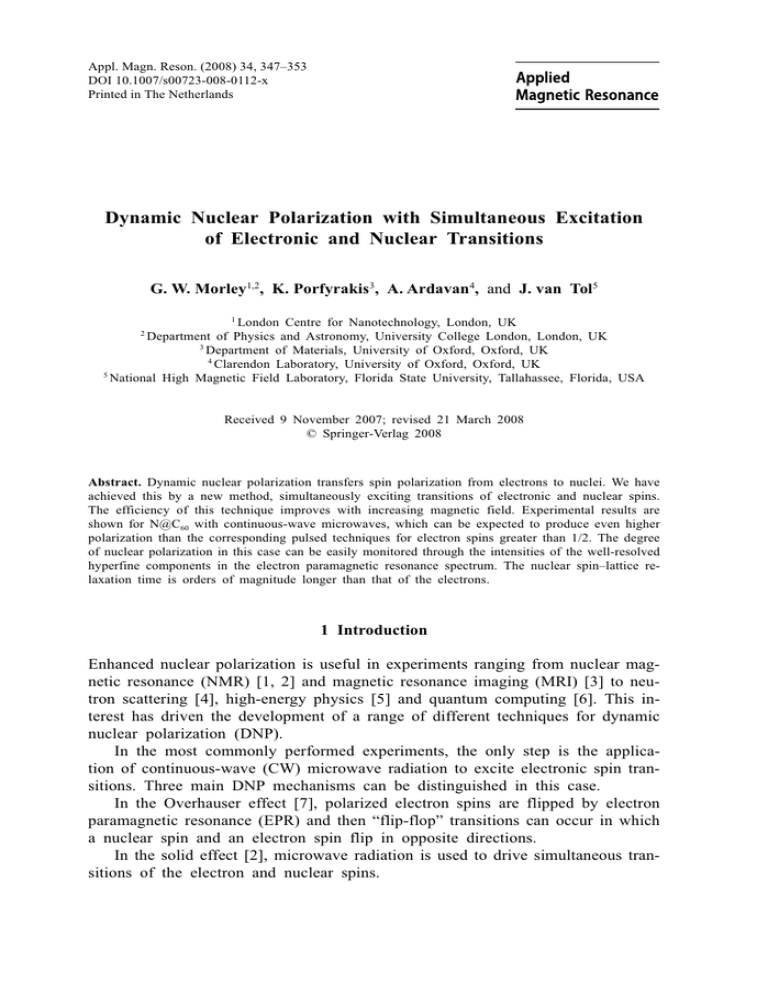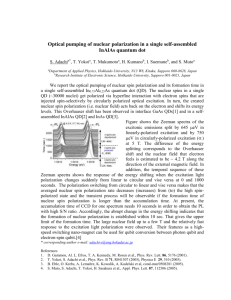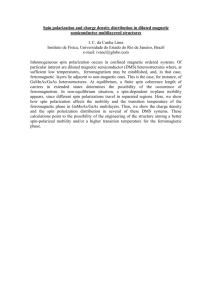Dynamic Nuclear Polarization with Simultaneous ... of Electronic and Nuclear Transitions
advertisement

Appl. Magn. Reson. (2008) 34, 347353 DOI 10.1007/s00723-008-0112-x Printed in The Netherlands Dynamic Nuclear Polarization with Simultaneous Excitation of Electronic and Nuclear Transitions G. W. Morley1,2, K. Porfyrakis3, A. Ardavan4, and J. van Tol5 1 London Centre for Nanotechnology, London, UK Department of Physics and Astronomy, University College London, London, UK 3 Department of Materials, University of Oxford, Oxford, UK 4 Clarendon Laboratory, University of Oxford, Oxford, UK 5 National High Magnetic Field Laboratory, Florida State University, Tallahassee, Florida, USA 2 Received 9 November 2007; revised 21 March 2008 © Springer-Verlag 2008 Abstract. Dynamic nuclear polarization transfers spin polarization from electrons to nuclei. We have achieved this by a new method, simultaneously exciting transitions of electronic and nuclear spins. The efficiency of this technique improves with increasing magnetic field. Experimental results are shown for N@C60 with continuous-wave microwaves, which can be expected to produce even higher polarization than the corresponding pulsed techniques for electron spins greater than 1/2. The degree of nuclear polarization in this case can be easily monitored through the intensities of the well-resolved hyperfine components in the electron paramagnetic resonance spectrum. The nuclear spinlattice relaxation time is orders of magnitude longer than that of the electrons. 1 Introduction Enhanced nuclear polarization is useful in experiments ranging from nuclear magnetic resonance (NMR) [1, 2] and magnetic resonance imaging (MRI) [3] to neutron scattering [4], high-energy physics [5] and quantum computing [6]. This interest has driven the development of a range of different techniques for dynamic nuclear polarization (DNP). In the most commonly performed experiments, the only step is the application of continuous-wave (CW) microwave radiation to excite electronic spin transitions. Three main DNP mechanisms can be distinguished in this case. In the Overhauser effect [7], polarized electron spins are flipped by electron paramagnetic resonance (EPR) and then flip-flop transitions can occur in which a nuclear spin and an electron spin flip in opposite directions. In the solid effect [2], microwave radiation is used to drive simultaneous transitions of the electron and nuclear spins. 348 G. W. Morley et al. The thermal mixing effect [2] uses flip-flop transitions between two electron spins and one nuclear spin. Several extensions of DNP have been demonstrated. Experiments in which the sample is suddenly heated from cryogenic temperatures have produced huge DNP enhancements of e ` 10000 [1] (where e is defined as the nuclear polarization after DNP divided by the nuclear polarization beforehand). However, the constant-temperature DNP polarization in these experiments was due to the thermal mixing effect providing a polarization of only 26% at 1.1 K. Optical excitation can supply over 60% electronic polarization of pentacene at room temperature leading to DNP enhancements of e " 5500 after 60 min of the integrated solid effect [8]. With pulsed EPR using spin locking pulses around 10 ms long, DNP enhancements of e " 1014 have been recorded after 20 min [9]. Combining optical excitation with 100 ns EPR pulses has produced DNP with a total irradiation period of just 10 s [10]. However, all of the experiments mentioned so far rely on transitions that are not magneticdipole allowed, meaning the rates are lower than for dipole-allowed transitions such as EPR and NMR. As the magnetic field is increased, this problem becomes worse, and the DNP rates can be low with respect to the nuclear spinlattice relaxation rate (1/T1n), thereby reducing the DNP enhancement. Any DNP technique at high magnetic fields benefits from a larger electronic polarization for a given temperature. Efficiently using this polarization is the subject of this paper. Further, many applications of DNP require high magnetic fields of 320 T, where the approaches described so far are not efficient. For example, NMR experiments benefit from higher spectral resolution as the magnetic field is raised. The problem of nondipole-allowed transitions can be avoided by driving the electronic transitions with micro- or millimeter waves and the nuclear spins with radio frequency waves. Electronnuclear double resonance (ENDOR) experiments have been observed to produce nuclear polarization in this way [11]. One experiment has deliberately used NMR to produce DNP, making use of only magneticdipole allowed EPR and NMR transitions [12]. However, this used fast-passage EPR and did not perform EPR and NMR simultaneously. This technique is not optimum as is discussed below for the different cases in which the electron spin is S " 1/2 and S ` 1/2. 2 Materials and Methods We have increased the nuclear polarization from ENDOR by exciting only those transitions that provide the desired DNP. This technique produces a polarization of nuclear spins enhanced by ENDOR (PONSEE) [6]. PONSEE works best in cases where the EPR spectrum shows well-resolved hyperfine splitting. The EPR of only those spins whose nuclei are in an unwanted spin state are selectively excited. NMR is used to flip those nuclei to the desired spin state. Performing High-field PONSEE 349 PONSEE with simultaneous EPR and NMR has led to a nuclear polarization of 62% [6] at a field of 8.6 T and a temperature of 3 K, corresponding to a DNP enhancement factor of e " 1100. Combining PONSEE with a temperature jump [1] may lead to even larger DNP than either one alone. The nuclear polarization can be conveniently measured in our experiments simply by comparing the areas of the EPR corresponding to the different nuclear spin states. The EPR is saturated due to the long relaxation times, but the saturation is expected to have the same effect for the different nuclear spin states [13]. Hence the difference in the areas of hyperfine components in the EPR spectrum is attributable to the nuclear polarization. All of the measurements we have performed are consistent with this understanding. Polarization of nuclear spins enhanced by pulsed ENDOR (PONSEPE) would use pulsed electronic and nuclear spin excitation. This is similar to a fast-passage experiment performed previously [12], but PONSEPE could be much faster, particularly when compared with more traditional forms of DNP. If the aim is to enhance nuclear polarization without concern for the electron spin, then it is not necessary to wait for the electronic spinlattice relaxation T1e. In this case the PONSEPE sequence consists simply of an electronic p-pulse followed by a nuclear p-pulse. The total duration of this preparation would be limited only by that of the nuclear p-pulse: typically on the order of 20 µs. It may then be possible to create nuclear polarization orders of magnitude faster than previous DNP preparations that take more than 10 s. The source of PONSEPEs speed would be that only a single cycle should be needed. This would avoid the fast-passage scan that takes several seconds [12], and the nondipole allowed transitions in other DNP schemes. PONSEPE is expected to be most efficient for systems with electron spin S " 1/2 as discussed below. N@C60 is a nitrogen atom trapped inside a fullerene [14]. The sample was prepared by ion implantation [15] and purified with high-performance liquid chromatography (HPLC) [16]. The purified sample was dissolved in molten sulfur in a quartz EPR tube. The tube was sealed under a dynamic vacuum, and the sulfur crystallized. Measurements were made with a high-field CW EPR spectrometer [17] that has recently been upgraded for pulsed operation [18]. 3 Results Figure 1 shows CW EPR performed with 240 GHz microwave excitation. The C60 cage has no EPR signal, but the nitrogen atom has an electronic spin of 3/2. The nuclear spin of nitrogen is I " 1, apart from an 0.4% abundance of 15N. Previous PONSEE measurements with 15N@C60 used a small sample leading to low signal-to-noise ratios [6]. The N@C60 sample used for the experiments described here contained orders of magnitude more spins, leading to a stronger signal. The dashed curve in Fig. 1 shows three resonances with the expected hyperfine splitting of 0.56 mT. The measurement was made with field modulation. The absorption-like line shape indicates that each resonance is saturated due to the G. W. Morley et al. CW EPR signal 350 Thermalized After PONSEE 8.569 8.570 8.571 8.572 Magnetic field (T) Fig. 1. CW EPR measurements before and after CW PONSEE of N@C60 using 240 GHz radiation at 4 K. long electron spinlattice relaxation time [13]. We have previously reported that T1e for N@C60 in this environment reaches 4.5 min at a field of 0.33 T and a temperature of 4 K [19]. While this is a long value for T1e, it is still much shorter than T1n. For any DNP to be effective, the T1n should be long compared with the time taken for the nuclear polarization to be generated. For CW PONSEE, this condition corresponds to T1n @ T1e. The decay of nuclear polarization produced in N@C60 by PONSEE indicates that T1n ` 1 day at 4.2 K. This measurement lacks precision because the longest time for which the system was allowed to decay was 38 h, and only seven such points were recorded. The CW ENDOR scan in Fig. 2 shows the expected resonances at 2.7, 18.5, 34.2 and 50 MHz, corresponding to the nuclear transitions for the electron spin Sz " 3/2, 1/2, #1/2 and #3/2, respectively. Each of these resonances consists of the two degenerate transitions Iz " 0 G Iz " )1, as quadrupole effects in this high symmetry system are effectively zero. The ENDOR line widths were around 50 kHz. A strong artefact is present at 100 MHz (not shown) that is smaller at 50 MHz and smaller still at 25 MHz. We attribute this behavior to the spectrometer electronics rather than to the superimposed ENDOR resonance at 50 MHz. The solid curve in Fig. 1 shows the effect of CW PONSEE. This was achieved by holding the magnetic field on the high-field EPR resonance while sweeping the radio frequency from 1 to 4 MHz for 45 min (though almost the same degree of the polarization enhancement was achieved after only 20 min). High-field PONSEE 351 25 MHz artefact 50 MHz artefact CW ENDOR signal and S z = -3/2 S z = -1/2 S z = 3/2 S z = 1/2 0 5 10 15 20 25 30 35 40 45 50 ENDOR frequency (MHz) Fig. 2. CW ENDOR spectrum of N@C60 using 240 GHz radiation at 4 K. After PONSEE, the area of the high-field resonance is only 8% of the area of all three resonances. Before PONSEE, the expected thermal population of the high-field resonance is 33.31% with a magnetic field of 8.57 T and a temperature of 4 K. This takes into account the increased hyperfine coupling of 14N due to its presence in a C60 cage [6]. 4 Discussion For the quantum information applications we are considering [6, 1922], the electron spin should relax back to its polarized state before the preparation is complete. This means that PONSEPE is not much faster than the CW version for these applications, as both processes are limited by the electronic T1. Also it is desired that the states that have not been emptied by PONSEE should contain the same polarization, which is achieved by CW PONSEE, but not with a single cycle of PONSEPE. For an electron spin S ` 1/2 (such as the S " 3/2 case in N@C60), CW PONSEE is expected to provide more total polarization than a single cycle of PONSEPE. Figure 3 shows the reason for this: CW PONSEE provides some nuclear polarization to all molecules, while a single cycle of PONSEPE only affects those molecules that have their electron spin flipped by the p-pulse. At the end of a PONSEPE cycle, reapplying steps 2, 3 and 4 as indicated in Fig. 3 352 G. W. Morley et al. 1.Thermal equilibrium 2. EPR pulse 3. NMR π-pulse e 4. T1 relaxation Target of next PONSEPE cycle Fig. 3. Schematic representation of a single cycle of PONSEPE for a spin system with S " 1 and I " 1/2. In each of the four panels, the three horizontal lines on the left represent the three electronic spin states with one of the nuclear spin states. The three lines on the right correspond to the same electronic spin states, having the other nuclear spin state. Each ball semiquantitatively represents some population in an energy level. Electronic spinlattice relaxation is the only relaxation mechanism considered in this simple picture. A spin system with electron spin S " 1 and nuclear spin I " 1/2 is chosen as the simplest case in which CW PONSEE provides greater nuclear polarization than a single cycle of PONSEPE. will lead to an increased nuclear polarization. As the number of cycles is increased the polarization grows towards the CW limit. Acknowledgments This work was supported in part by an IHRP grant from the National High Magnetic Field Laboratory (NHMFL) and by the Engineering and Physical Sciences Research Council through the Quantum Information Processing Interdisciplinary Research Collaboration (nr. GR/S82176/01) and grant numbers GR/S23506 and EP/D049717. The experiments were performed at the NHMFL (supported by National Sciences Foundation cooperative agreement nr. DMR-0084173, by the State of Florida, and by the Department of Energy). A.A. is supported by the Royal Society. References 1. Ardenkjaer-Larsen, J.H., Fridlund, B., Gram, A., Hansson, G., Hansson, L., Lerche, M.H., Servin, R., Thaning, M., Golman, K.: Proc. Natl. Acad. Sci. USA 100, 10158 (2003) 2. Weis, V., Griffin, R.G.: Solid State Nucl. Magn. Reson. 29, 66 (2006) 3. McCarney, E.R., Armstrong, B.D., Lingwood, M.D., Han, S.: Proc. Natl. Acad. Sci. USA 104, 1754 (2007) High-field PONSEE 353 4. van den Brandt, B., Glättli, H., Grillo, I., Hautle, P., Jouve, H., Kohlbrecher, J., Konter, J.A., Leymarie, E., Mango, S., May, R.P., Stuhrmann, H.B., Zimmer, O.: Physica B 335, 193 (2003) 5. Meyer, W.: Nucl. Instrum. Methods Phys. Res. A 526, 12 (2004) 6. Morley, G.W., van Tol, J., Ardavan, A., Porfyrakis, K., Zhang, J., Briggs, G.A.D.: Phys. Rev. Lett. 98, 220501 (2007) 7. Overhauser, A.W.: Phys. Rev. 92, 411 (1953) 8. Henstra, A., Lin, T.-S., Schmidt, J., Wenckebach, W.T.: Chem. Phys. Lett. 165, 6 (1990) 9. Henstra, A., Dirksen, P., Schmidt, J., Wenckebach, W.T: J. Magn. Reson. 77, 389 (1988) 10. Macho, V., Stehlik, D., Vieth, H.-M.: Chem. Phys. Lett. 180, 398 (1991) 11. Epel, B., Pöppl, A., Manikandan, P., Vega, S., Goldfarb, D.: J. Magn. Reson. 148, 388 (2001) 12. Feher, G., Gere, E.A.: Phys. Rev. 103, 501 (1956) 13. Harbridge, J.R., Rinard, G.A., Quine, R.W., Eaton, S.S., Eaton, G.R.: J. Magn. Reson. 156, 41 (2002) 14. Murphy, T.A., Pawlik, T., Weidinger, A., Höhne, M., Alcala, R., Spaeth, J.-M.: Phys. Rev. Lett. 77, 1075 (1996) 15. Lips, K., Waiblinger, M., Pietzak, B., Weidinger, A.: Phys. Status Solidi A 177, 81 (2000) 16. Kanai, M., Porfyrakis, K., Briggs, G.A.D., Dennis, T.J.S.: Chem. Commun. (Cambridge) 2, 210 (2004) 17. van Tol, J., Brunel, L.-C., Wylde, R.J.: Rev. Sci. Instrum. 76, 074101 (2005) 18. Morley, G.W., Brunel, L.-C., van Tol, J.: Rev. Sci. Instrum. 79, 064703 (2008) 19. Morley, G.W.: D.Phil. thesis, University of Oxford, Oxford, UK, 2005. 20. Harneit, W.: Phys. Rev. A 65, 032322 (2002) 21. Ardavan, A., et al.: Philos. Trans. R. Soc. London A 361, 1473 (2003) 22. Morton, J.J.L., Tyryshkin, A.M., Ardavan, A., Porfyrakis, K., Lyon, S.A., Briggs, G.A.D.: Phys. Rev. Lett. 95, 200501 (2005) Authors address: Gavin W. Morley, London Centre for Nanotechnology, 1719 Gordon Street, London WC1H 0AH, United Kingdom E-mail: g.morley@ucl.ac.uk



